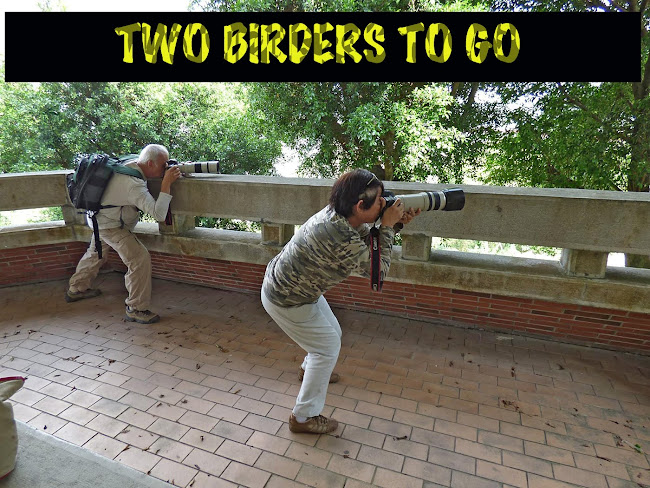Then I saw a silhouette of a bird perched on an electric wire. I walked slowly towards it. Blue Rock Thrush! I only managed to get a few backlit shots before it flew off and completely disappeared from view.
Cynthia detected some movement in the brush. The brown bird popped up and promptly returned back into the dense foliage. The only feature that we both noticed, aside from its color, was its long tail. Could it be the furtive Long-tailed Ground Warbler? Sadly, it never reappeared for us to confirm our suspicions. I even tried to get near the bush where it hid itself hoping it would reappear. Something appeared alright but not the long-tailed skulker but rather a curious Siberian Rubythroat. Just a few feet from me! I was so surprised and excited that I got my camera settings all wrong and managed just a "documentary" shot.
I was about to join my wife when out of the blue, a small bird alighted on the electric wire above us. "Crossbill!" I shouted. We both took pictures and to our delight it flew down to the "landslide" area just as Jho had predicted. Soon it was joined by its less colorful mate. Cynthia and I were surprised and even amazed at the cooperativeness of this pair of Red Crossbills. They just fed on the tiny plants growing besides the rocks as if a couple of human beings holding cameras were not there.
Past ten in the morning and it was us that got tired of photographing these uncommon montane species. We checked out the summit but failed to encounter either the Mountain Shrike or the Fire-breasted Flowerpecker. We were about to board our vehicle when I saw a raptor gliding below us. It was my wife who was better at BIF (birds in flight) shots who got a few photos. It was another puzzler, made even more difficult to identify because of the great distance between the bird and the photographer. It turned out to be an Eastern Buzzard, another lifer for us! (Thanks, Jho, for the ID)
On the way down, the only species we encountered were a flock of Mountain White-eyes and (now I'm quite sure) a Paddyfield Pipit.
We were at the eco-trail a little before 11. It was not long after when Cynthia alerted me. "I can hear them!"she said. First came a huge flock of Mountain White-eyes. Then a solitary Grey-streaked Flycatcher stopped by. A totally unexpected sighting was that of a Colasisi or Philippine Hanging Parrot!
While I was enjoying my colasisi, my wife was photographing a mystery bird. Unfortunately it was behind a patch of greenery and totally backlit that her shots were all too dark. I can only figure out that it had an orange breast and a blackish head with a tiny strip of white behind the eye. It was while we were comparing the results of our photographic endeavors that another lifer appeared. We added Turquoise Flycatcher to our list.
Happy with our encounter, we broke off for lunch. Past one pm and we were back this time at the eco-trail by the paintball area. Jho told us this was where the mixed flock "wave" passes through. True enough as soon as we were among the pines that the flock came. First was the Sulphur-billed Nuthatch (too far, too dark) then a Citrine Canary-Flycatcher dropped by. It was followed by the Chestnut-faced Babbler (a lifer but no good photo), then a Blue-headed Fantail and finally, an Elegant Tit.
 |
| Citrine Canary-Flycatcher |
 |
| Blue-headed Fantail |
 |
| Elegant tit |
We had a wonderful time in Baguio - thanks to our friend, Jocelyn Alberto-Floresca, for showing us the birding places in the area. Because of that, we added five lifers to our list: Island Thrush, Red Crossbill, Chestnut-faced Babbler, Eastern Buzzard and Turquoise Flycatcher. We thought about planning a return trip, perhaps stay longer so we can don our tourist hats too. Or just concentrate on birding again. Who knows?



























